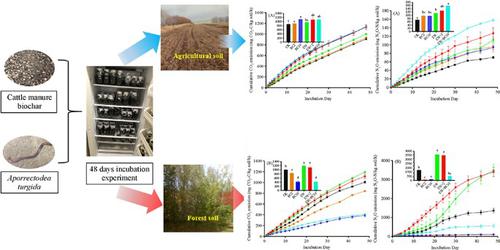Frontiers of Environmental Science & Engineering ( IF 6.4 ) Pub Date : 2021-07-15 , DOI: 10.1007/s11783-021-1473-8 Xiaoqiang Gong 1, 2, 3 , Jinbiao Li 1, 4 , Scott X. Chang 1 , Zhengfeng An 1 , Xiangyang Sun 2 , Suyan Li 2 , Hui Wang 3 , Qian Wu 5 , Chengpeng Huang 6

|
The application of manure-derived biochar offers an alternative to avoid the direct application of manure to soil causing greenhouse gas emission. Soil fauna, especially earthworms, can markedly stimulate carbon dioxide (CO2) and nitrous oxide (N2O) emissions from soil. This study therefore investigated the effect of cattle manure biochar (added at rates of 0, 2%, or 10%, coded as BC0, BC2 and BC10, respectively) application, with or without earthworm Aporrectodea turgida, on emissions of CO2 and N2O and changes of physic-chemical properties of agricultural and forest soils in a laboratory incubation experiment. The BC10 treatment significantly enhanced cumulative CO2 emissions by 27.9% relative to the untreated control in the agricultural soil. On the contrary, the BC2 and BC10 treatments significantly reduced cumulative CO2 emissions by 16.3%–61.1% and N2O emissions by 92.9%–95.1% compared to the untreated control in the forest soil. The addition of earthworm alone significantly enhanced the cumulative CO2 and N2O fluxes in agricultural and forest soils. Cumulative CO2 and N2O fluxes were significantly increased when BC2 and BC10 were applied with earthworm in the agricultural soil, but were significantly reduced when BC10 was applied with earthworm in the forest soil. Our study demonstrated that biochar application interacted with earthworm to affect CO2 and N2O emissions, which were also dependent on the soil type involved. Our study suggests that manure biochar application rate and use of earthworm need to be carefully studied for specific soil types to maximize the climate change mitigation potential of such management practices.
中文翻译:

牛粪生物炭和蚯蚓相互作用影响农业和森林土壤中的 CO2 和 N2O 排放:观察明显差异
粪肥衍生生物炭的应用提供了一种替代方法,可避免将粪肥直接施用于土壤而导致温室气体排放。土壤动物群,尤其是蚯蚓,可以显着刺激土壤中的二氧化碳 (CO 2 ) 和一氧化二氮 (N 2 O) 排放。因此,本研究调查了牛粪生物炭(以 0、2% 或 10% 的比例添加,分别编码为 BC0、BC2 和 BC10)应用,有或没有蚯蚓Aporrectodea turgida对 CO 2和 N排放的影响实验室培养试验中农林土壤2 O和理化性质的变化。BC10 处理显着提高了累积 CO 2与农业土壤中未经处理的对照相比,排放量减少了 27.9%。相反,与未处理的森林土壤对照相比,BC2 和BC10 处理显着减少了累积CO 2排放量16.3%–61.1% 和N 2 O 排放量92.9%–95.1%。单独添加蚯蚓显着提高了农业和森林土壤中累积的CO 2和N 2 O 通量。累积 CO 2和 N 2在农业土壤中,BC2和BC10与蚯蚓一起施用时,O通量显着增加,而在森林土壤中,BC10与蚯蚓一起施用时,O通量显着降低。我们的研究表明,生物炭应用与蚯蚓相互作用会影响 CO 2和 N 2 O 排放,这也取决于所涉及的土壤类型。我们的研究表明,需要针对特定土壤类型仔细研究粪便生物炭的施用率和蚯蚓的使用,以最大限度地发挥此类管理实践的气候变化减缓潜力。



























 京公网安备 11010802027423号
京公网安备 11010802027423号